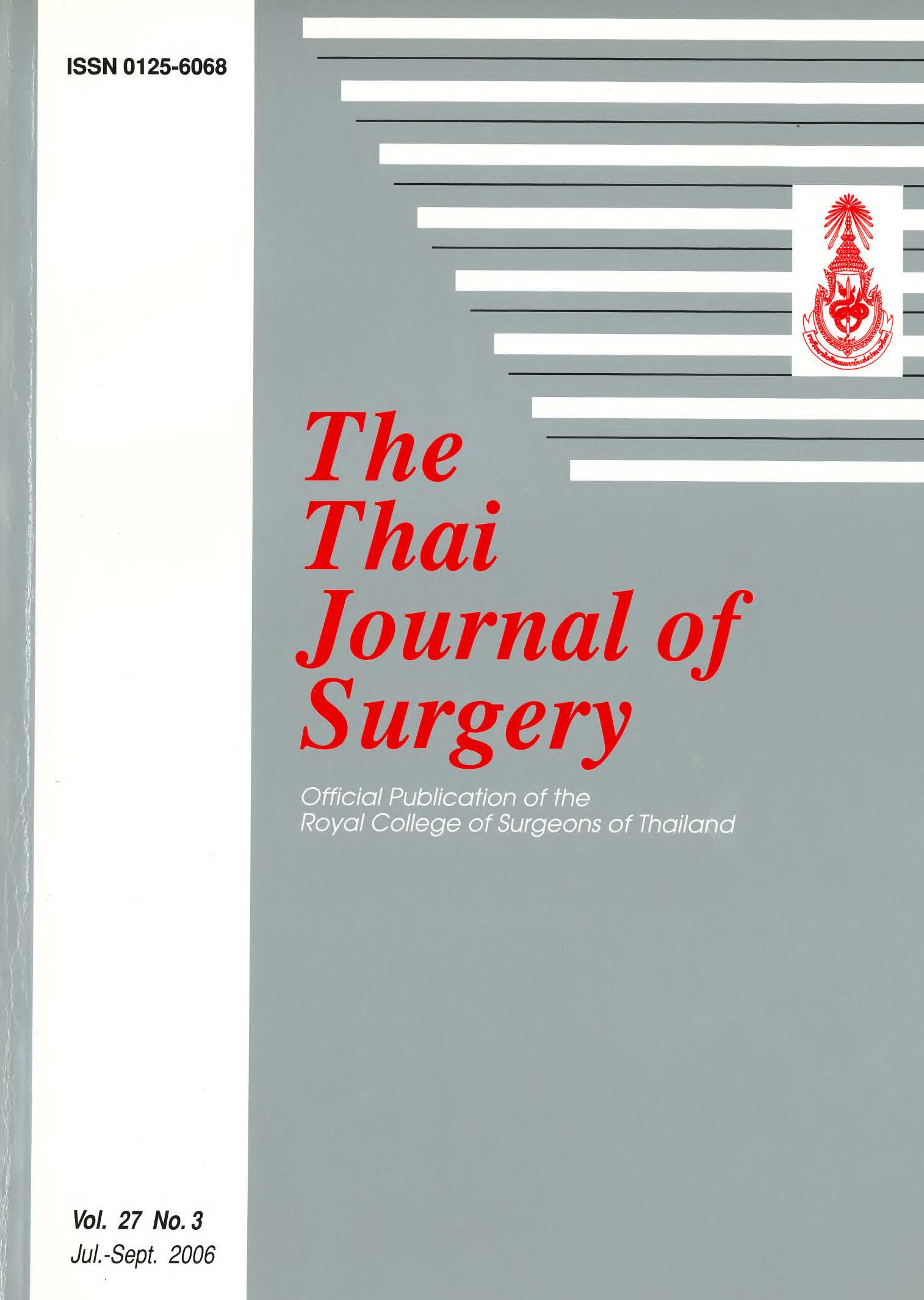Comparison of Results of Radiocephalic Arterio- Venous (RCAV Fistulas for Long-Term Hemodialysis between, Original Technique and Pongsapak Modified Technique
Abstract
Background: The radiocephalic arteriovenous fistula (RCAV) has been proved to be safe and effective vascular access for chronic hemodialysis. The incidence of fistula failure or complications is extremely low. The purpose of this study was to compare the effectiveness and complication rates between the original technique of radiocephalic arteriovenous fistula and the Pongsapak modified technique.
Materials and Methods: Radiocephalic arteriovenous fistulas were performed in 80 patients with chronic renal failure at Phrae Hospital from January 2002 to October 2005. Half of them (40/80) were performed using the original technique and the other half (40/80) with the Pongsapak modified technique. Demographic data, blood flow rate, duration of function, thrombotic complications, infection rates, number of operations and cost were analysed.
Results: The data were analyzed and compared using Mann-Whitney U test for two independent groups. The results of this study revealed that the Pongsapak modified technique was more effective with fewer complications compared with the original technique (P<.01). This modified technique gave satisfactory results not only by increasing the size of the fistula but also by decreasing visible scar by S-plasty incision at the wrist. Once established, the incidence of fistula failure and thrombosis has been extremely low and the incisional scar is less perceptible.
Conclusions: The Pongsapak modified technique of arteriovenous fistula at the wrist has proved to be a safe and effective means of gaining vascular access for chronic hemodialysis. The technique was well accepted by patients, physicians and dialysis personnel. The author recommends the use of Pongsapak modified technique for the creation of radiocephalic AV fistulas for long-term hemodialysis.
References
2. Haimov M. Vascular access for hemodialysis. Surg Gyn Obstet 1975;141:619-23.
3. Klauber GT, Belitsky P, Morehouse DD, MacKinnon KJ. Preventable problems with arteriovenous fistulas for hemodialysis. Surg Gynecol Obstet 1971; 132: 457.
4. Palder SB, et al. Vascular access for hemodialysis: patency rates and results of revision. Ann Surg 1985; 202: 235-9.
5. Rohr MS, Browder W, Frentz GD, McDonald JC. Arteriovenous fistulas for long-term dialysis. Arch Surg 1978; 113: 153-5.
6. Sung TWD, Woods EJ. Modified technique for creation of an arteriovenous fistula for hemodialysis. Am J Surg 1973; 126:441.
7. Thompson BW, Barbour G, Bissett J. Internal arteriovenous fistula for hemodialysis. Am J Surg 1972; 124: 785.
8. Mizumoto D, et al. The treatment of chronic hemodialysis vascular access by Directional Artherectomy. Nephrom1996;74:45-52.
9. Patel R, Lidsky I, Vertes V, et al. Some experiences with the use or arteriovenous fistulae in chronic haemodialysis. Br Med J 1968;1: 414.
10. Tungsnga K, et al. Theory Of hemodialysis. Bangkok: Chuanpim, 1994: 67-80.
11. Brescia MJ, Cimino JE, Appel K, Hurwich BJ. Chronic hemodialysis using venipuncture and a surgically created arteriovenous fistula. N Eng J Med 1966; 275: 1089-92.
12. Ramirez O, Swartz C, Onesti G, et al. The winged in line shunt. Trans Am Soc Artif Intern Organs 1966; 12: 220.
13. Cerilli J, Limbert JG. Technique and results of the construction of arteriovenous fistulas for hemodialysis. Surg Gynecol Obstet 1973;137:922.
14. Hanson JS, Carmondy M, Keogh B, O'Dwyer WF. Access circulation by permanent arteriovenous fistula in regular dialysis treatment. Br Med J 1967; 4: 586.
15. Hodson JM, Menno AD, McMahon J. Radial arteriovenous fistula as a substitute for the conventional arterial prosthesis in maintenance hemodialysis. J Urol 1970; 103: 5.
16. Kinnaert P, Geens M, Vereerstraeten P, et al. Experience with arteriovenous fistulas in chronic hemodialysis. Am J Surg 1971; 122: 104.
17. Tungsnga K, et al. Hemodialysis. Bangkok: Text and Journal Publication, 2002:147-212.
18. Sangiamjit P, et al. Practical hemodialysis. Bangkok: Text and Publication, 2002: 189-276.
19. Ariyakajorn V. Hemodynamics and pathophysiology of arteriovenous fistula. Department of Surgery, Faculty of Medicine, Chiang Mai University Press, 1-35.
20. Triratworakul P. Surgery. No 15 (Vascular Access for General Surgeon). Bangkok: Bangkok Medical Publisher, 1997: 503-37.
21. Salomon J, Vidne B, Robson M, et al. Our experience with the use of arteriovenous fistula in chronic dialysis; modified surgical technique. Surgery 1968; 63: 899.
22. Jirasiritham S, Triratworakul P, Pimolsarn R. Textbook of Vascular Surgery. Bangkok: Bangkok Medical Publisher,2002:423-44.
23. McCarthy JG, Introduction to Plastic Surgery. In: McCarthy JG, editor.Plastic surgery Vol. 1. General Principles. Philadelphia: WB Saunders, 1990; 1-68.
24. Haimov M, Burrows L, Casey JD, Schupak E. Vascular access for hemodialysis: experience with 214 patients; special problems and causes for early and late failures. Proc Eur Dial Transpl Assoc 1973; 9: 173.
Downloads
Published
How to Cite
Issue
Section
License
Articles must be contributed solely to The Thai Journal of Surgery and when published become the property of the Royal College of Surgeons of Thailand. The Royal College of Surgeons of Thailand reserves copyright on all published materials and such materials may not be reproduced in any form without the written permission.



